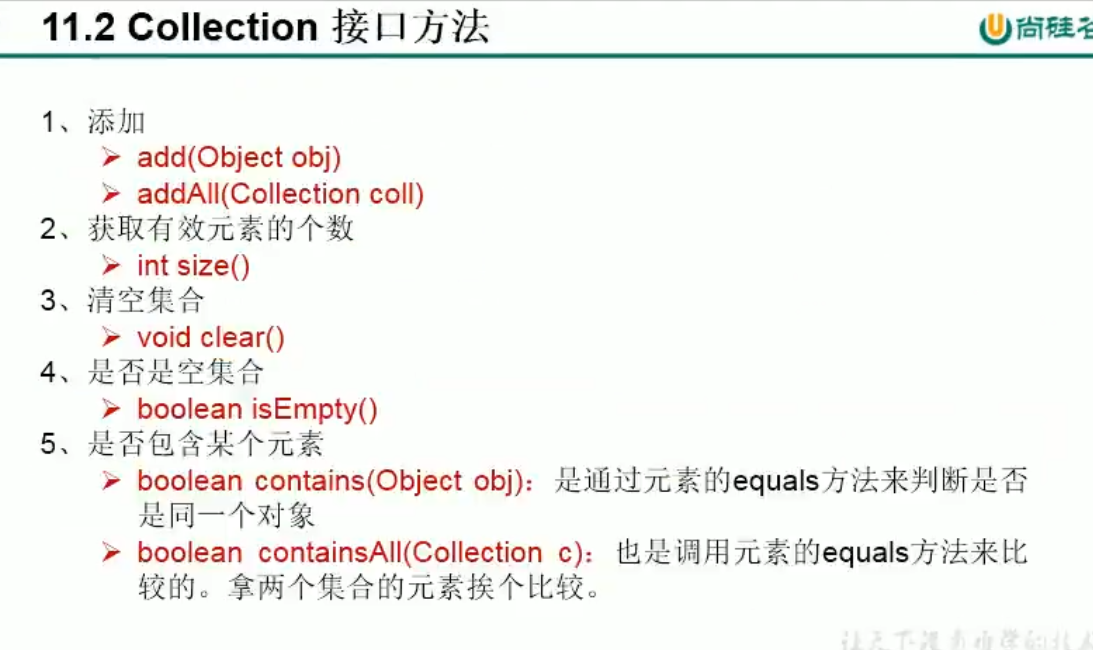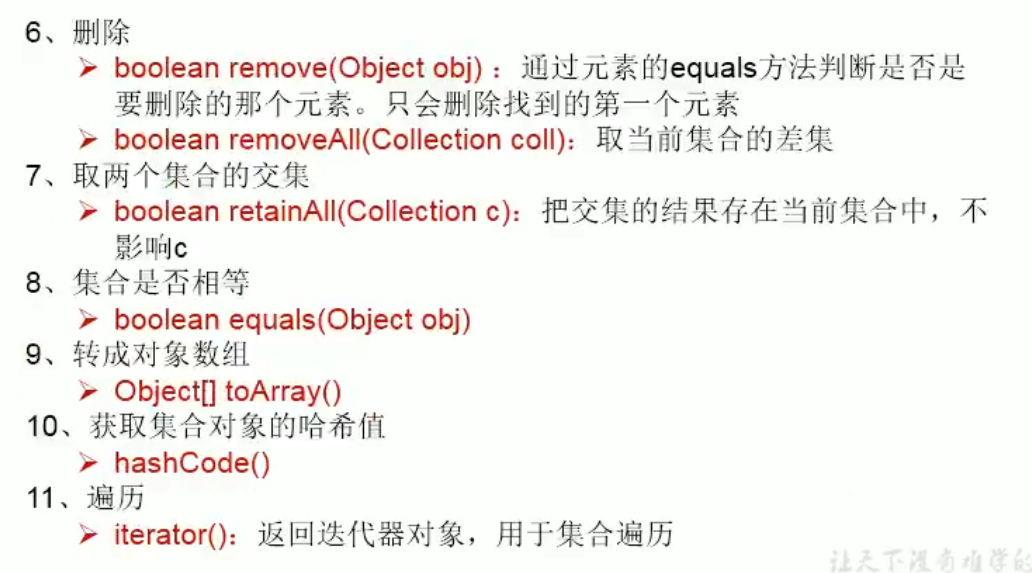

- 向Collection接口的实现类的对象中添加数据obj时,要求obj所在类要重写equals().
Collection没有提供直接的实现类,而是提供了List、Set实现类
1.结合Collection中存储的如果是自定义类的对象,需要自定义类重写哪个方法?为什么?
equals()方法
List:equals()方法
Set:(HashSet、LinkedHashSet为例) : equals()、hashCode()
(TreeSet为例) : Comparable:comparaeTo(Object obj)
Comparator:compare(Object o1,Object o2)f
package com.atguigu.java1;import org.junit.Test;import java.util.*;/*** Collection接口中声明的方法的测试** 向Collection接口的实现类的对象中添加数据obj时,要求obj所在类要重写equals().** @author Dxkstart* @create 2021-05-19 14:05*/public class CollectionTest1 {@Testpublic void test(){Collection coll = new ArrayList();//1.add(Object e):将元素e添加到集合coll中coll.add("AA");coll.add("BB");coll.add(123);coll.add(new Date());//2.size():System.out.println(coll.size());System.out.println(coll);//3.addAll(Collection coll1):将coll集合中的元素添加到当前的集合中Collection coll1 = new ArrayList();coll1.add("WW");coll.addAll(coll1);System.out.println(coll.toString());//4.clear():清空集合中的元素coll.clear();//5.isEmpty():判断集合是否为空System.out.println(coll.isEmpty());}@Testpublic void test1(){Collection coll = new ArrayList();coll.add("AA");coll.add(123);coll.add(new String("Tom"));coll.add(new Person("Jerry",20));coll.add(false);//6.contains(Object obj):判断当前集合中是否包含obj//我们在判断时会调用obj对象所在类的equals()。boolean contains = coll.contains("AA");System.out.println(contains);System.out.println(coll.contains(new String("Tom")));//true,用equals比较的System.out.println(coll.contains(new Person("Jerry",20)));//false//没有重写equals()//7.containsAll(Collection coll1):判断形参coll1中的所有元素是否都存在于当前集合中。Collection coll1 = Arrays.asList(123,456);System.out.println(coll.containsAll(coll1));}@Testpublic void test2(){//8.remove(Object obj):从当前集合中移除obj元素Collection coll = new ArrayList();coll.add("AA");coll.add(123);coll.add(new String("Tom"));coll.add(new Person("Jerry",20));coll.add(false);System.out.println(coll.size());System.out.println(coll.remove(123));System.out.println(coll.size());coll.remove(new Person("Jerry",20));System.out.println(coll.size());//9.removeAll(Collection coll1):差集:从当前集合中移除coll1中所有的元素Collection coll1 = new ArrayList();coll1.add(false);coll.removeAll(coll1);System.out.println(coll.size());}@Testpublic void test3(){Collection coll = new ArrayList();coll.add("AA");coll.add(123);coll.add(new String("Tom"));coll.add(new Person("Jerry",20));coll.add(false);//10.retainAll(Collection coll1):交集:获取当前集合和coll1集合的交集,并返回给当前集合Collection coll1 = Arrays.asList(123,456,789);coll.retainAll(coll1);System.out.println(coll);//11.equals(Object obj):要想返回true,需要当前集合和形参集合的元素都相同。System.out.println(coll.equals(coll1));}@Testpublic void test4(){Collection coll = new ArrayList();coll.add("AA");coll.add(123);coll.add(new String("Tom"));coll.add(new Person("Jerry",20));coll.add(false);//12.hashCode():返回当前对象的哈希值System.out.println(coll.hashCode());//13.toArray():集合 ----> 数组Object[] arr = coll.toArray();for(int i = 0;i<arr.length;i++){System.out.println(arr[i]);}//拓展:asList():数组 ---->集合:调用Arrays类的静态方法asList()List<Object> list = Arrays.asList(arr);System.out.println(list);List arr1 = Arrays.asList(new int[]{123, 456});System.out.println(arr1);//这样会识别成一个数,不对List arr2 = Arrays.asList(123, 456);System.out.println(arr2);//14.iterator():返回Iterator接口的实例,用于遍历集合元素。放在IteratorTest.java中测试}}
package com.atguigu.java1;/*** @author Dxkstart* @create 2021-05-19 14:15*/public class Person {private String name;private int age;public Person() {}public Person(String name, int age) {this.name = name;this.age = age;}public String getName() {return name;}public void setName(String name) {this.name = name;}public int getAge() {return age;}public void setAge(int age) {this.age = age;}@Overridepublic String toString() {return "Person{" +"name='" + name + '\'' +", age=" + age +'}';}@Overridepublic boolean equals(Object o) {System.out.println("Person equals()....");if (this == o) return true;if (o == null || getClass() != o.getClass()) return false;Person person = (Person) o;if (age != person.age) return false;return name != null ? name.equals(person.name) : person.name == null;}// @Override// public int hashCode() {// int result = name != null ? name.hashCode() : 0;// result = 31 * result + age;// return result;// }}

